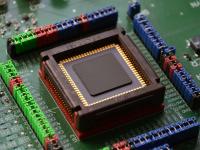BioSoC or how to monitor human health
A system allowing to monitor vital functions of drivers and machine operators is within arm’s reach. A team from the Faculty of Electronics and Information Technology supervised by Professor Witold Pleskacz, PhD, Eng has constructed a BioSystem-on-Chip, which can monitor vital functions.
Institute of Microelectronics and Optoelectronics at the Faculty of Electronics and Information Technology of the Warsaw University of Technology is one of few units in Poland, which specialise in microchip design. It should not surprise anyone that scientists of WUT have been given the task to develop a new technology, which allows for dynamic monitoring of the vital functions.
The construction of the BioSystem-on-Chip (BioSoC) has formed a part of the project entitled “Integrated circuit technology for measurement of psychophysiological parameters under dynamic conditions”. BioSiP is a mini module, which integrates measurement functions and capabilities of modern diagnostic equipment. The measurement system can become an attractive element of new generation mobile devices and an element of health monitoring and healthcare systems.
Five in one
The BioSoC chip integrates systems that monitor psychophysiological parameters, such as heart electrical activity (ECG), electrical activity of muscles (EMG), body temperature, stress level (skin resistance) and breath rate. The silicon integrated circuit incorporates several analogue paths, analogue/digital signal processing circuits and a microcontroller.
The compact structure guarantees greater reliability. Moreover, it consumes less power, so it can be battery-operated. Last, but not least the manufacturing of microchips is less expensive.
A prototype version of BioSoC has been manufactured in a short series. The integrated circuit is composed of 4.6 million transistors and the silicon structure is 5mm x 5mm (25 mm2) in size. It has 84 pins.
Guarding safety
This technology allows to monitor psychophysiological parameters in humans under dynamic conditions, e.g. in pilots, tram drivers or heavy machinery operators while they are working.
– If such a person collapses while working, they can cause a disaster and may pose a threat to their or other people’s lives, says professor Witold Pleskacz. Thanks to the device, which constantly monitors vital functions of such professionals, we can control their health and intervene in case of emergency.
Quite often, those people when performing their professional duties are not in contact with others, who could help them in life threatening conditions. The microchip can send a signal to employers who can instruct their employees to stop working and call medical assistance.
Private monitoring device
The system allows for collecting, analyzing and interpreting information with the use of one integrated circuit only. This is an incomparable achievement on the global scale. Thanks to the above mentioned features, the invention forms an excellent basis for developing technical solutions for mobile devices, especially for the fast developing wearables.
Primum non nocere
The work of the scientists of the Faculty of Electronics and Information Technology combined medical and engineering science. This is why the cooperation with of the Institute of Medical Technology and Equipment and the Military Institute of Aviation Medicine, who provided medical knowledge, was of paramount importance.
– For many of our team members, this was the first biomedical project and we needed to acquire non-engineering knowledge, says Krzysztof Siwiec, M.Sc.Eng, a doctoral student at the Institute of Microelectronics and Optoelectronics, who worked on the BioSoC project. – We needed to know what parameters our system is supposed to read and learn applicable standards. As a matter of fact, when designing, you need to look for original solutions and think out of the box.
Obviously, the device designed by the scientists from the Warsaw University of Technology is not to replace equipment, which you can find at hospitals or outpatient clinics. Collecting information, such as electrical activity of the heart, is more difficult in dynamic conditions and less accurate than ECG test performed by a medical professional. The role of the device is to simply monitor. In the future, it could be used to observe vital functions of patients who require regular medical care, e.g. those who suffered a heart attack, recovering after heart surgeries, and cardiovascular disease sufferers.
Appreciated on the international arena
The invention has already been appreciated by scientific circles. The WUT scientists were awarded a gold medal and a special mention during the 64th BRUSSELS INNOVA 2015 Fair and a gold medal at INOVA CROATIA 2015 International Innovations Show.
The scientists carried out the project funded by the National Centre for Research and Development from October 2012 till April 2016. The project was implemented by a consortium comprising the Institute of Medical Technology and Equipment (project leader), Military Institute of Aviation Medicine, Warsaw University of Technology, Institute of Electron Technology, and FONON Sp. z o. o. (industry partner).
Monika Bukowska
Office for Promotion and Information








